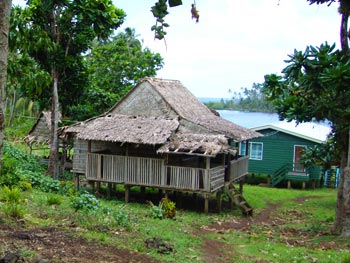(Read Part 2 and Part 3 of this blog post)
The bow of the open aluminium boat jumped from wave to wave, cutting deeply into the white-topped wave crests and adding salt spray to the rain that was showering us constantly with wind-blown pin prick-like strikes. The helmsman then turned towards the shore, slowly bringing the boat into shallow water beside a small wooden pier, where we were able to climb gingerly ashore.
The helmsman was Wilson, Team Leader for the Solomon Islands Rural Development Project (RDP) in the Western Province, and he was accompanied by Lottie, the RDP Project Manager. RDP is a Solomon Islands government project supported by the World Bank, Australia, the European Union and the International Fund for Agricultural Development. Graham (my colleague on this mission) and I were in the Solomon Islands as part of an evaluation of the World Bank's work in the Pacific, funded by the Australian Agency for International Development (AusAID). The RDP had been selected as a case study project for us to visit.
The RDP uses an approach to rural development known broadly as Community Driven Development, or CDD. CDD projects vary from country to country as they have to be designed to fit in with local reality. In the Solomon Islands, rural villages in participating provinces were invited to identify their top priority community development project. In each area the highest priority project amongst all the area villages was financed in the first year (“cycle 1”) and then further villages received projects in subsequent years (“cycle 2 etc.”).
Our first destination was a village called Temarae. Very soon after we started it began to rain lightly. The route took us into a narrow passage between two islands, and then out towards the open sea. To our right large trawlers were moored and then a large factory appeared – the Solomon Taiyo tuna processing plant that mainly supplies Sainsbury’s, a large supermarket chain in the United Kingdom.
 |
| Behind the dilapidated structure is the Temarae health post that's under construction. |
When we reached Temarae the rain stopped and we walked into the small village. This was a “cycle 3” village and they had recently had a grant agreed for a health post. The government had confirmed that if the villagers and project built a small nursing station and a house for a nurse they would staff it. We asked why the village only scored third priority. The team pointed out that this village already had a water supply, a secondary school (a boarding school serving the surrounding area), small solar powered battery chargers and a basic wharf. Less well equipped villages will have scored higher on the priority list.
One of the concerns we had about RDP was the risk that the government would not be able to staff all the new schools and health posts being built. However in this case that did not seem to be an issue – the villagers already knew the name of the nurse who was coming and they expected him in a few months time. The health post was still no more than a wooden frame, but we were assured that what takes time is getting the wood (from the forests on the island) and the sand and gravel (from nearby beaches). The villagers had already done this, and the project contribution – roofing materials, paint, equipment, were already on their way. This project should be up and running in a few months.
We returned to the boat and headed back past the Solomon Taiyo plant. The waves and rain were coming from behind us now, and this meant a slightly calmer ride. To our right was a huge thickly forested volcanic island, but our destination was a “cycle 2” project in the village of Baeroko on another island. The landing here was just made from a pile of dead coral rocks, and the climb through the rain into the village a very slippery manoeuvre over mud and coral.
At the top we found another health post under construction. Four men from the village were working on the structure, which was more advanced than the one at Temarae. The villagers explained that the community had divided themselves into three groups. Each group of three or four men worked two days a week on the building. However the materials promised by the project were long delayed. Wilson and Lottie explained to us that the World Bank financing process had proved very slow. It seemed very unfortunate that remote and poor local communities should be expected to contribute their labour and materials, and then be delayed by bureaucratic processes in Sydney, Manila or Washington. This “cycle 2” village did not seem to have many facilities, but perhaps they were out of our sight.
To be continued.



Join the Conversation